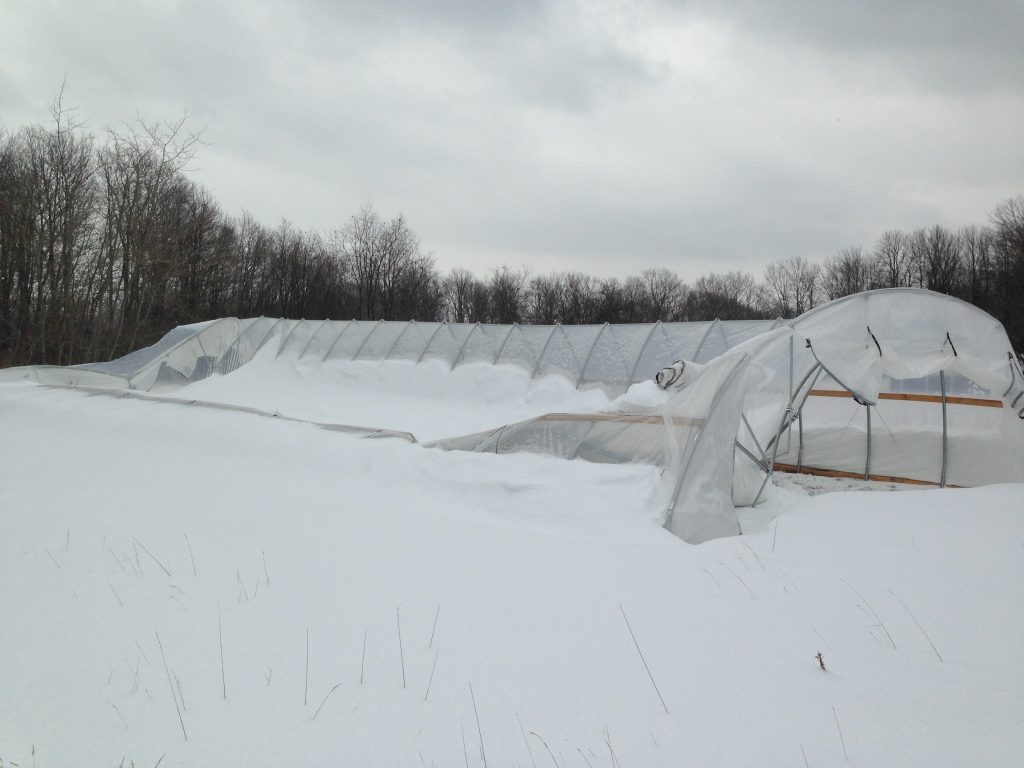A Certified Naturally Grown Farm - Saint Marys, Pennsylvania
Hop Farm | version 2.0
Posted on December 15, 2023 by Joshua

“Forward, always forward, everywhere forward“
Boniface Wimmer, O.S.B.
Founder & Archabbot, Saint Vincent Archabbey | Latrobe, Pennsylvania
1809 – 1887
It’s that time of year – harvest is behind us, hops are put to bed for the Winter, and there’s no work left to do in the fields. It’s time to sit back, reflect on the past season, and start making plans for next year.
And what a great way to reflect, than by literally drinking the “fruits of your labors”…
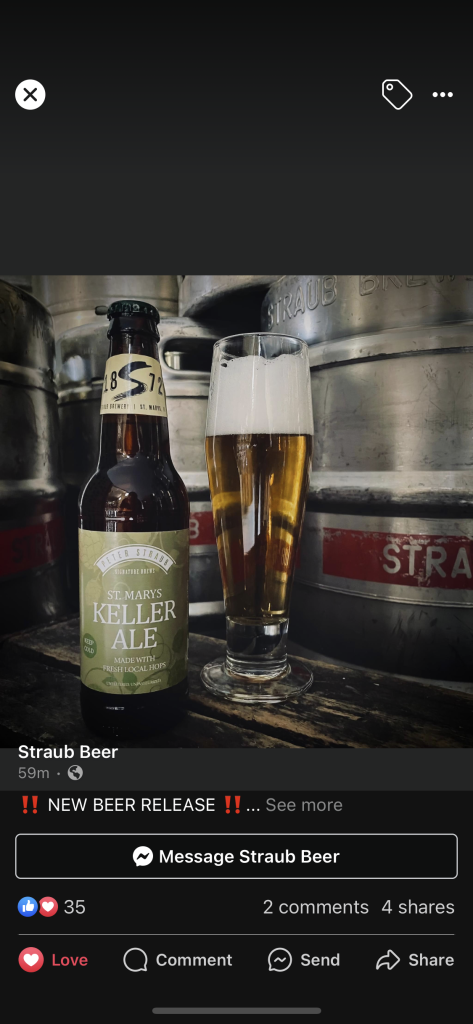
The next installment in our Brewery Exclusive Series is available starting today!
St. Marys Keller Ale is a spin on the classic style of Kellerbier from Franconia, Germany. Combining our lager brewing heritage with ale yeast instead of the traditional lager yeast we’ve created a smooth drinking beer with some fruity esters that compliment the mild bitterness of locally grown Cascade and Nugget Hops from Hoffman Appalachian Farm.
This brew is 5.5% ABV, unfiltered, unpasteurized and must be purchased cold and kept cold. Only available in 24 loose bottles, 6pks and draft at our Brewery Retail Store and at Straub Brewery Visitor Center & Tap Room
Phase 1 Complete
It’s hard to capture the feeling at the moment finally seeing this come to pass! It’s been a joint effort for certain. So many hours, primarily volunteered, by family and close friends – from putting in the hop yards, stringing the hops every Spring, tending to the hills through the season, special projects like putting in our solar irrigation system almost exclusively on our own, and especially at harvest time. There are many, many individuals are part of this accomplishment!
So what’s up with the “2.0” reference? Well, having a full-time job as a technical writer for an Atlassian partner/app developer, versions and builds are part of this Farmer’s other gig. But as with many aspects of life, things bleed into each other, many times quite beautifully and organically. The 2.0 reference is a common saying in our field of work, but it’s also found its way into the everyday vernacular. Webster’s defines it as “used postpositively to describe a new and improved version or example of something or someone“. You may recall sayings like “Web 2.0”, or “new me, version 2.0”.
In short, it means a new rendition – hopefully better or more improved – of an original product, service, or deliverable of some sort. In this instance, it’s a turning-of-the-corner, cresting of the hill (even if it’s a known false summit), a sigh of relief. We’ve been working on this for years, refining our processes (many of which are still quite manual), building capacity, learning and improving along the way. By no means does it mean we’ve arrived, just that phase 1 is complete.
The Plan…Wait…There Was A Plan?
Well, sort of. The original plan after moving back home from Colorado was to start with a small vegetable operation, possibly a CSA. And that was the route we started following. Put in a small garden plot where the small Hopyard now sits, figured out a temporary solution for irrigation, and then we decided to kick it up just a notch.
With not a lot (read “ZERO”) of funds, we constructed a homemade high tunnel using a technique found on YouTube. Using lumber we either had on hand up in the barn attic, or purchased from one of the local lumber yards, along with some PVC pipe for the ribs, and plastic sheeting from one of the commercial high tunnel manufacturers…even had a set of storm doors on either end that were leftovers from the house…we got it in place. And then came the winds…
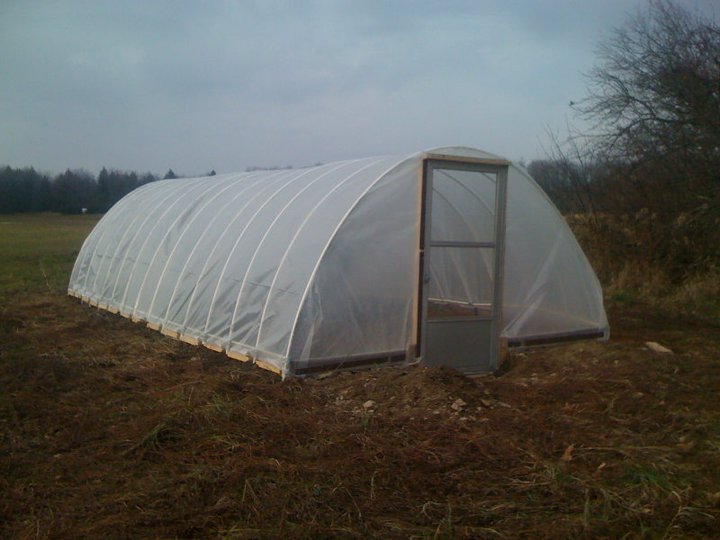
“That spot in the field, although it gets the most sun, it also gets horrendous wind.
Oh well, it’s gotta be able to take it…bring on Old Man Winter!!”
Long story short, it DIDN’T take it. The wind got in under the base, and even with it secured with multiple stakes into the ground, kicked it up, flipped it like a discarded plastic grocery bag, and deposited it about 15 feet about to where I was standing when this photo was taken.
High Tunnel = 0 | Wind = 1
Shortly after this event, I started to research the National Resource Conservation Service (NRCS) and their Environmental Quality Incentives Program (EQIP), and their grant program for high tunnels. In 2012 we applied and to our surprise, were awarded a grant for a rather large one, approximately 100’x 20′ for 4-season vegetable production. Truly seemed like maybe, just maybe, we were on our way.
We received the high tunnel in September 2012 via semi-trailer and unloaded it by hand (no tractor at this point). It was a bit overwhelming truth be told. If you think putting together a bed from IKEA and those instructions are a bit intimidating, this was that on steroids. Thankfully my father-in-law is a mechanical engineer and after a little cajoling, stepped in to help. Thank God as I was in over my head and never would’ve completed it by year’s end, which is when the contract needed to be completed.
And so we worked just about every weekend between October and early December until it was finished.
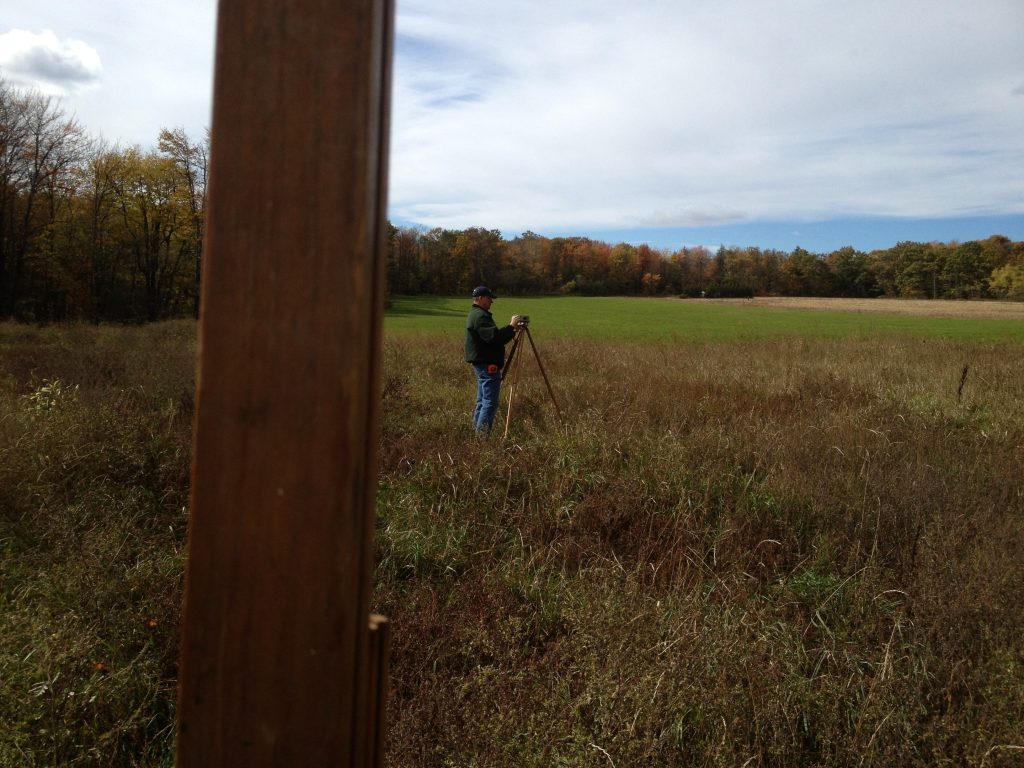


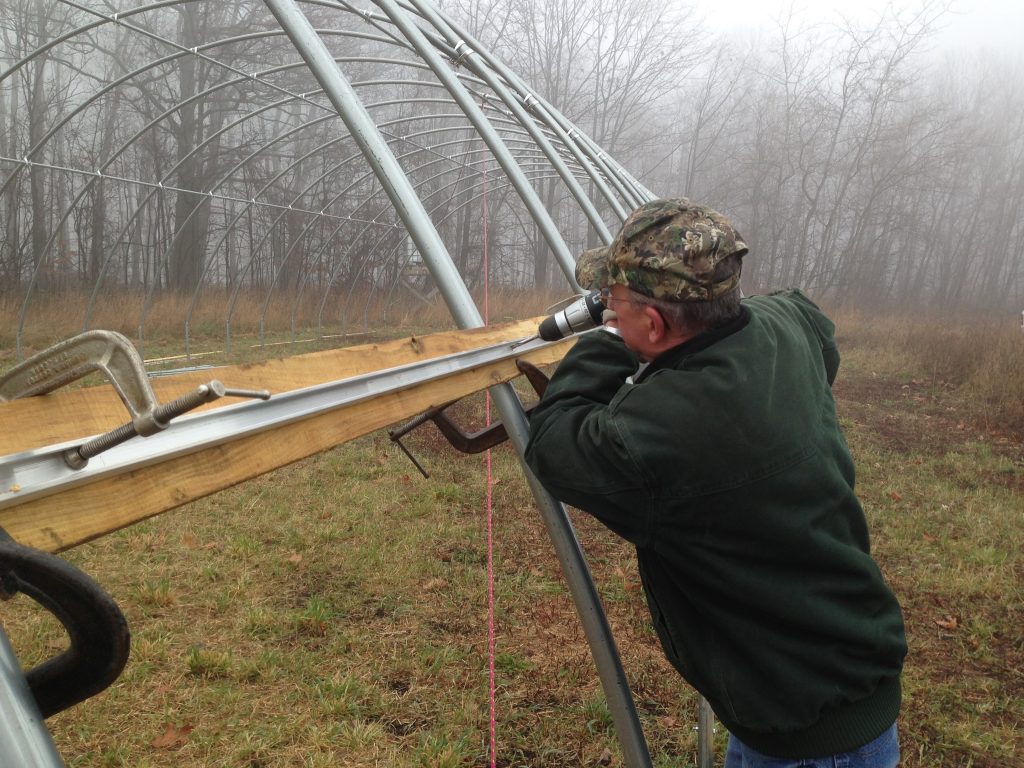


And there it stood, where our small Hopyard now sits, for about two weeks. Then came early December, along with those inevitable winds again and an ice storm, and well…
High Tunnel = 0 | Wind = 2
I clearly recall that day. I drove up from State College as I normally do during the season, I’d brought my XC skis as I wanted to get in a jaunt after checking out the high tunnel. As you can see from the photo, we’d gotten a fair amount of snow – snow and ice actually – the combination of which must’ve collected on the North side of the high tunnel and it was just too much. As I trudged up through the snow from the barn, I could tell something didn’t look right. I got about 100′ from it and realized what had happened. I immediately dropped to my knees and let out one of the loudest WTF’s I’ve ever uttered.
I was resolute that this was the final straw, the message from on high that Farming wasn’t in the cards for me. Between the 90-minute commute, events like this, not particularly productive soil…I’d had it. Or so I thought. We did take a break in 2013 with nothing happening at the Farm. Luckily insurance covered the high tunnel completely and we were able to repay back the grant. Although obviously not our fault, we didn’t meet the NRCS/EQIP requirements for the grant. We also got “dinged”, meaning we wouldn’t be able to apply for another grant for a few years. It was salt in the wound considering it was a weather-related, freak accident but such is life.
“Why Don’t You Try Hops?!” – Famous Last Words
Then came 2014 and I’m working at Pennsylvania Certified Organic (PCO) as their IT person. Lots of great folks there, loved my work, a great combination of my new-found passion in Ag along with my traditional tech background. During a conversation with a buddy of mine there, he mentioned he was growing 2 hop plants in his space at the PSU community garden. Pretty easy to care for, and definitely didn’t need to have the near-daily “love” shown to them like a vegetable crop would (at least for a small-sized planting). And one might think with one of the nation’s oldest, independent, family-owned breweries in town the idea was to grow hops for their use. Honestly, didn’t even cross our minds. We just wanted to give it a go.
And so in 2014, that buddy of mine (Adam Seitz), my uncle David Hoffman, my Dad, and I put in 6 black locust poles we’d sourced out of the Altoona area. This became what is now our small Hopyard. We then found an organic rhizome grower out of North Carolina and purchased 20 Cascade and 10 Nugget hop plants. We grew them under lights for a few weeks and planted them in late Spring. We were essentially on the way!



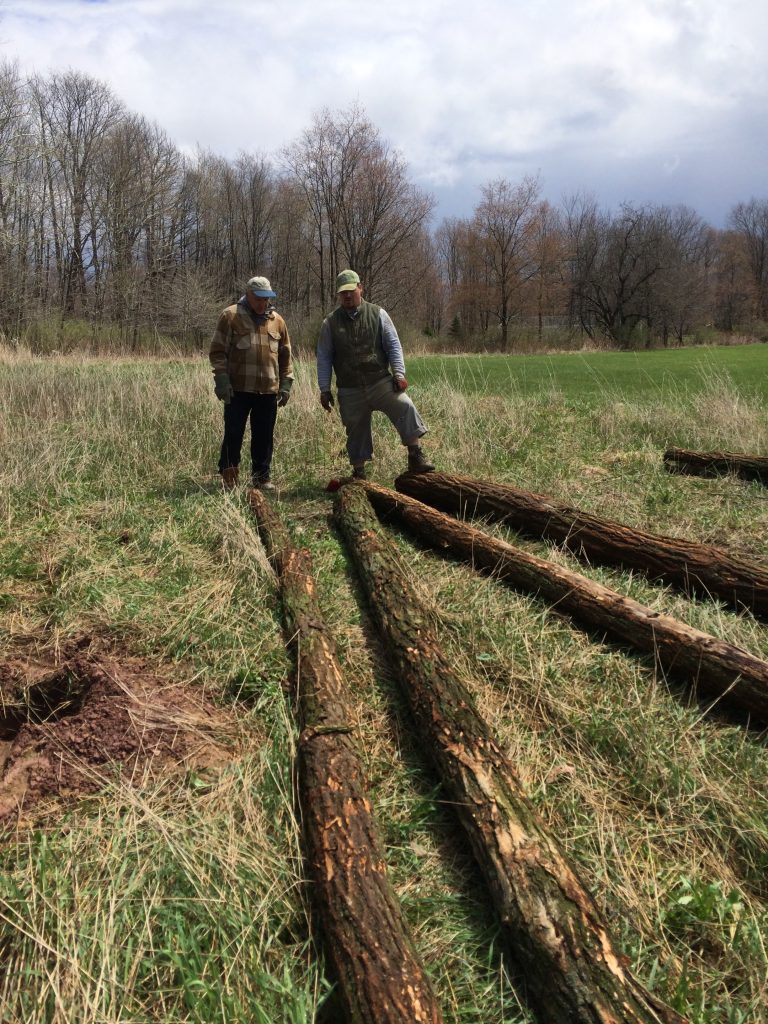

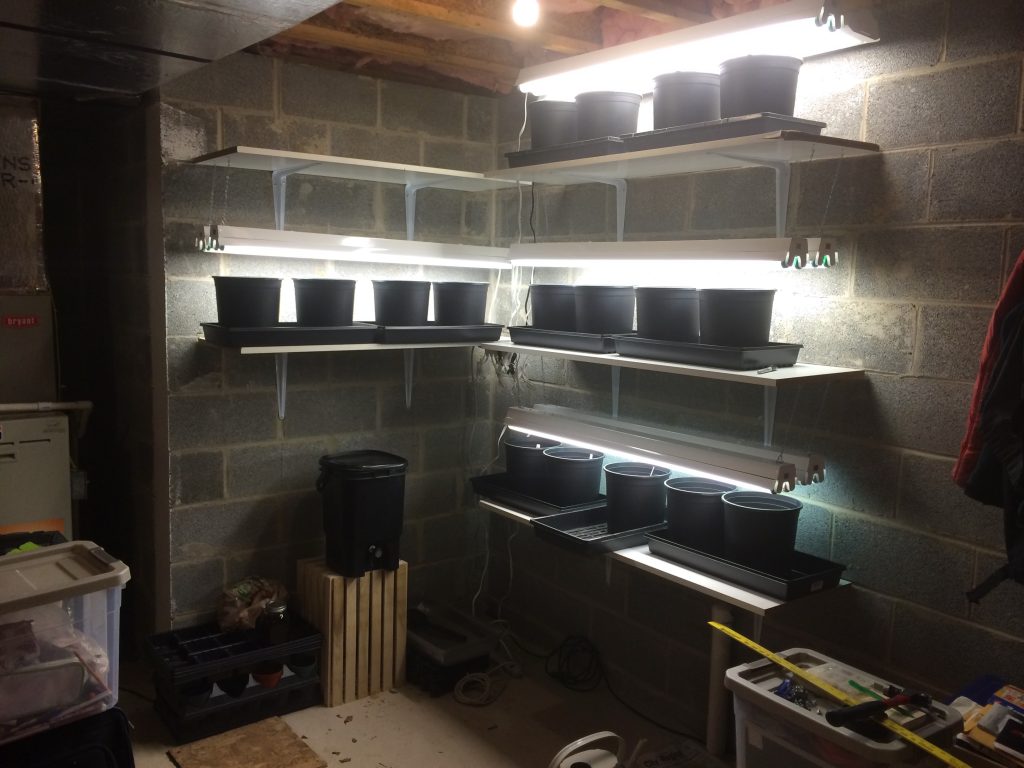
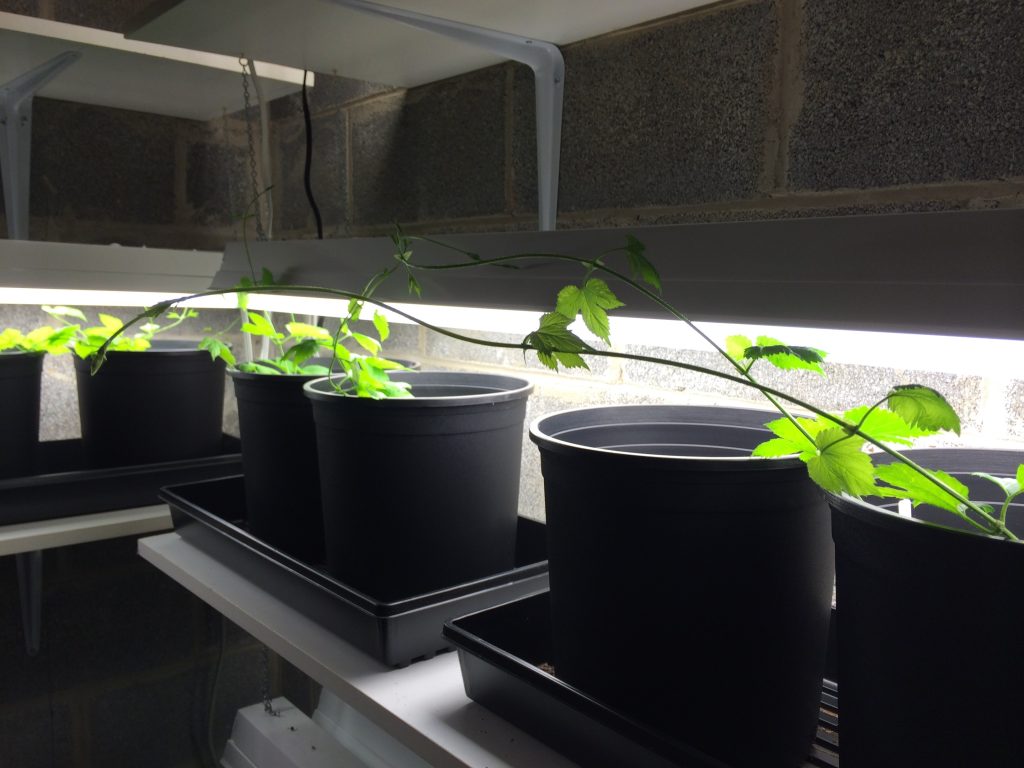



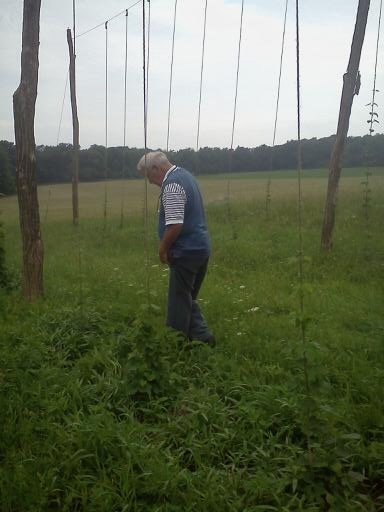
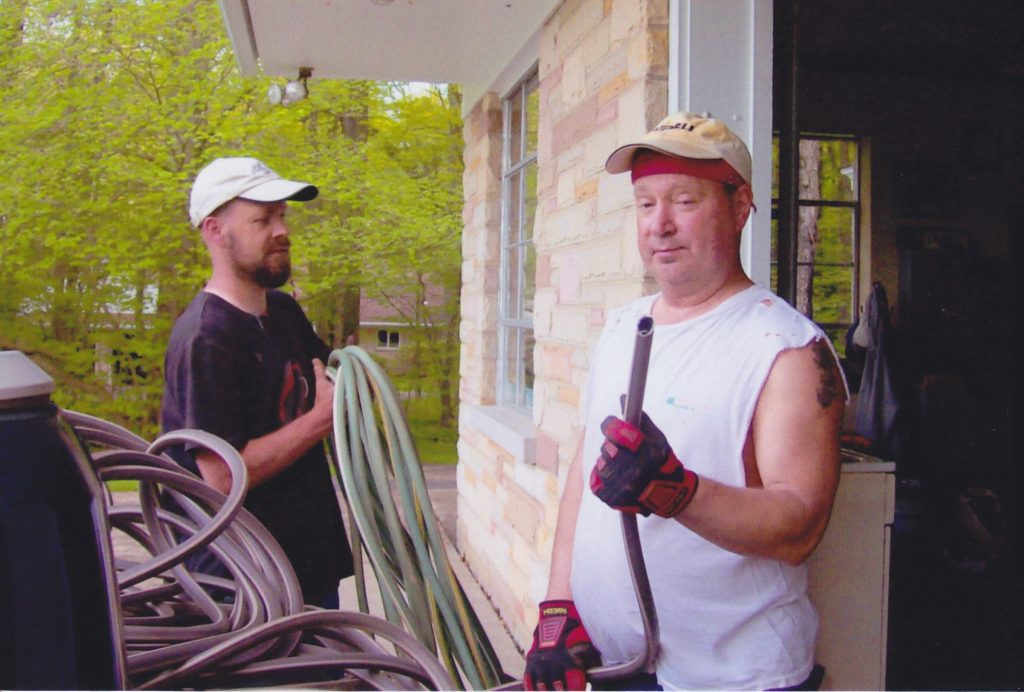

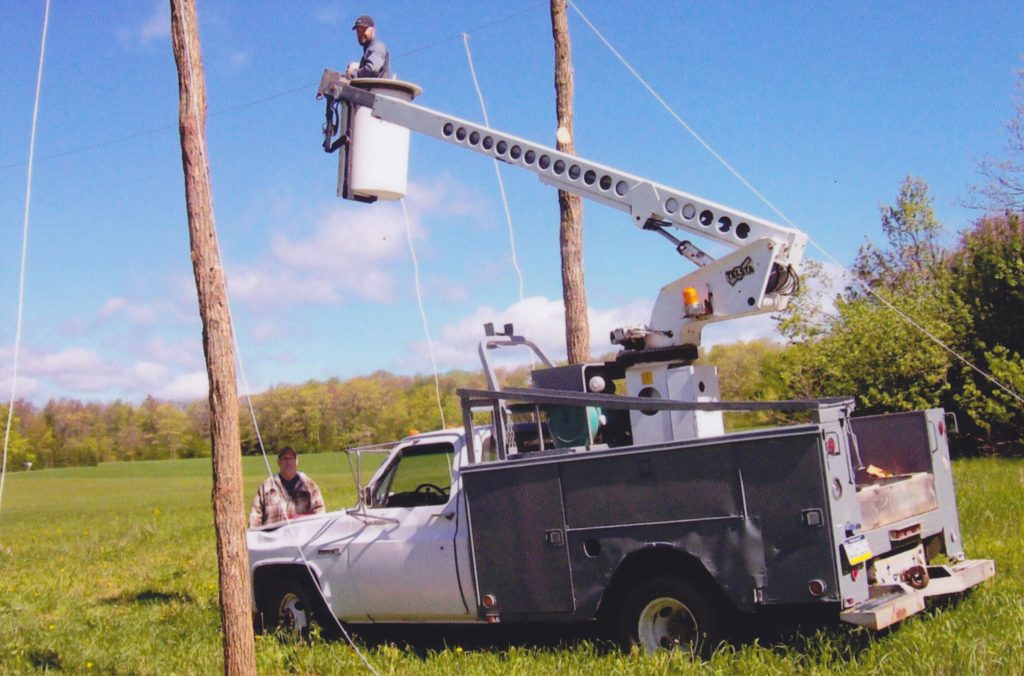
Again, there was no specific plan as to what we’d be doing with the hops once we harvested them. At the time, Adam was home brewing so I figured I’d give him some and maybe if we were lucky, sell a few bags. As they say, nothing goes unnoticed in a small town, and sure enough, word got back to Straub Brewery that we were growing hops locally. They already had a great source literally down the street from them to use in some R&D brews, but this would be a larger volume of local hops than what they’d had available to them previously. And so, we dropped off our harvest at the Brewery- one that my Dad and I completed by hand, on our own, as they were growing on the bines – in about 20 minutes. Comical considering the time and effort it takes now with just those 30 plants having matured.




Now I will say that that first R&D brew you see in the boil apparently didn’t turn out as hoped. They’d used the term “grassy” which now, with a few years under our belts, makes total sense as it was the very first year they were in the ground, AND, we had little clue as to when we the right time to harvest (i.e. moisture content / dry matter levels)…we sorta guessed.
Luckily there still apparently was interest in having some specialty brews made down the road, either exclusively with our hops or used in companion with hops the Brewery sourced from their much larger, annual contacted providers. The Head Brewer contacted me by phone, a plan was hatched for a much larger yard, and that’s when things took off…sort of. The year was 2015.
We turned to our black locust supplier in Altoona with an order for 35+ poles and contacted a Hopyard supplies distributor in NY state for all the cables, connectors, and equipment we’d need. My Dad and I surveyed out the area they’d be planted in which is at the Northwest corner of the property. A wide-open field that our leasing Farmer rotated his crops in. We snagged about a 1-acre area, dropped in markers for the poles, and awaited the black locust delivery
In the interim, one thing we’d learned was that while Black Locust is naturally rot resistant (the reason why many Farm used the wood for fence posts), with the bark left on it, it’d degrade quicker as it was a habitat for insects to fester and degrade the wood. This came as quite a shock as it meant we had to find a way to debark all those poles. We dabbled with a bark stripper that fit on the head of our chainsaw and while it did a fair job, it was slow and damaged the poles in addition to taking off the bark. And so we resigned ourselves to every weekend spending at least a day, my Dad and I, using the classic hand tools of a felled bark spud, felled draw knife, cant hook, and a sledgehammer…yes a sledgehammer!

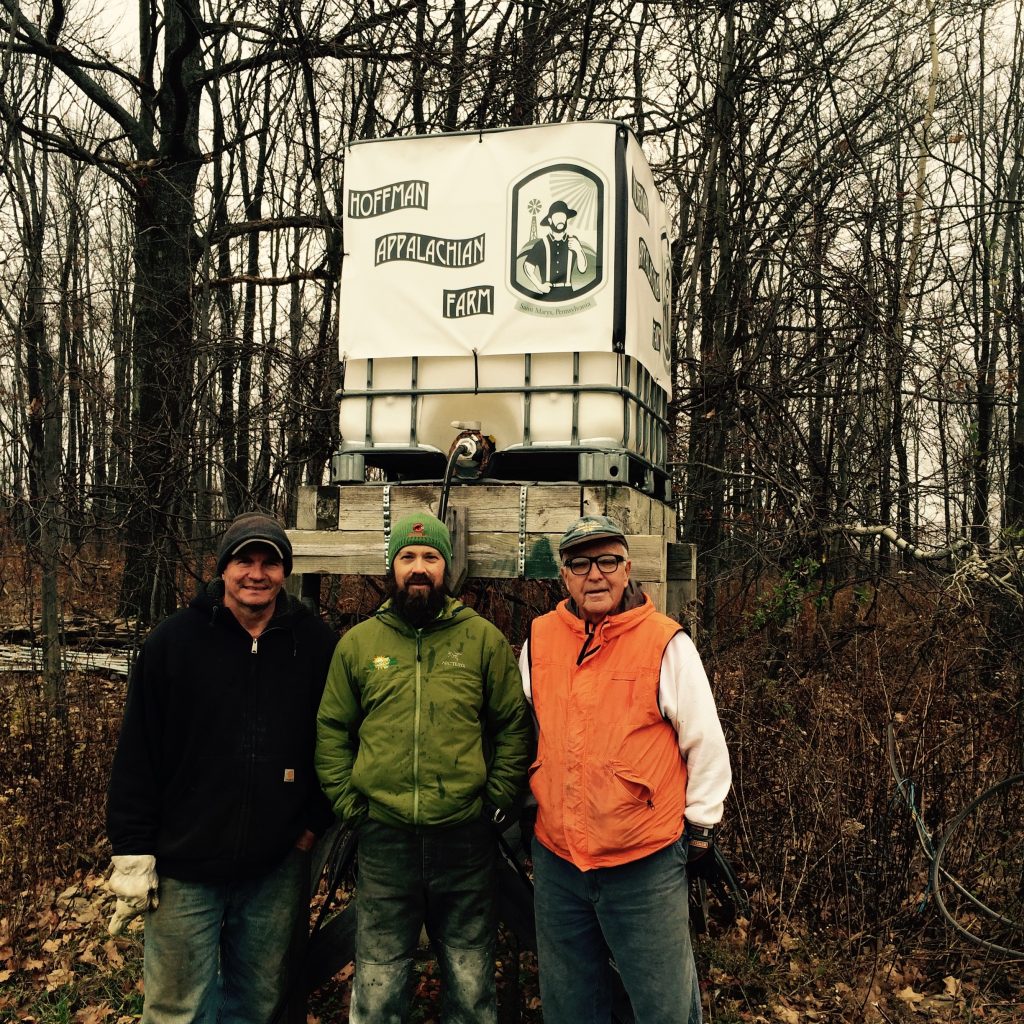
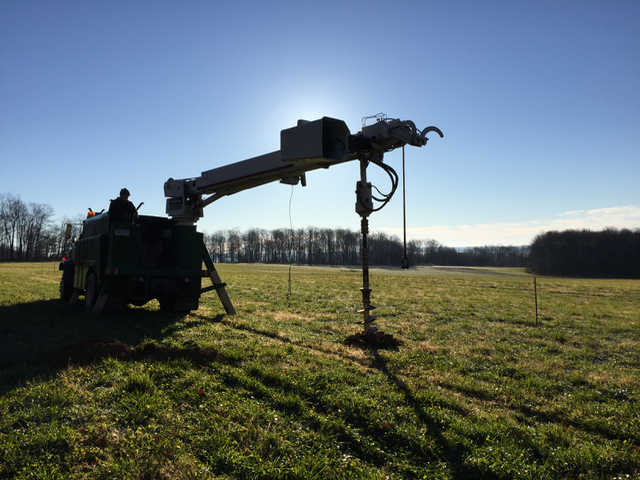
One of the great things about working at PCO was the folks I came into contact with. One of which, Tom Carey, who’d actually installed the network server at PCO a few years earlier and who I’d later work for at AccuWeather, told me that to really get the benefit of Black Locust, the bark had to come off, and a great way to do it was to smack it with a sledgehammer in a line which would help separate the bark from the core of the tree. Then we’d use the bark spud to peel it off. Many times it came off easily in these huge multi-food sheets, other times it was more finicky.
In any event, Dad and I spent hours up there going one by one through the logs, debarking them, rolling the debarked ones out of the way, and rolling a new one from the pile. It was hard work for sure, gave me a real appreciation for how it was done “back in the day”, particularly here locally in the original mills when Saint Marys was founded. Long story short…that already put us a season behind as we couldn’t plant the hops without the poles and infrastructure in place.
It was also at this point, that we realized we definitely did not have the equipment we’d need to run this expanded operation. We needed at the bare minimum a good tractor, a platform to string from, and a way to prep the soil…we had none of it, and again were struggling with little to no budget for what was essentially a hobby Farm at this point. We came across an organizer called Barnraiser which coordinates crowd-funding campaigns for just about anything under the sun. With a name like that, this must’ve been the group we were destined to go with.
And so from early October through early November of 2015, we put together and launched our Barnraiser campaign with the goal of getting enough funding for a solid, used tractor and any other implements we could find within that budget. Thankfully we met our goal and were able to purchase a solid, used International Harvester (IH) diesel tractor – ironically from my former boss at Appalachian Ski & Outdoors – along with a used commercial equipment trailer that would become our “siege tower”.
I feel it necessary to once again, thank those kind folks who helped make it all possible, we wouldn’t have been able to be where we are today without your support. Looking through the list, it’s a combination of heartfelt joy but also tinged with some sadness as I see a number of wonderful souls no longer with us.
Bigger Yard, Bigger Responsibilities, Bigger Headaches
I write that header with a slight smirk on my face. When we were approached about putting in a larger yard, we were very early in our hop-growing experience. As such, it was hard to plan and comprehend the amount of time and effort that would be involved in going from 30 plants to almost 500, from a quarter-acre to almost an acre of hops.
As this had been very much a “hobby” project up to this point, it was primarily me (Joshua) doing the majority of the day-to-day work and family members assisting with the bigger projects. There wasn’t a plan (or budget) to bring on additional help – full-time, part-time, or seasonal – to assist with those daily projects like weeding, mowing, training and trimming of the hops, spraying, etc. And so once we got the new hops planted in the larger Hopyard and strung, an effort that took 4-5 of us, it would then revert back to me as the primary, sometimes exclusive, field worker to maintain them and get them through the season to harvest.
It was, as the header suggests, a series of headaches, particularly given the time constraints at the Farm only 1 sometimes 2 days a week. In 2016, we had our original smaller yard with 30 rhizomes planted and then the larger Hopyard with 480 rhizomes planted. Yowza. It quickly became evident that I’d need to find a way to split my time between the yards over a day or weekend and that proved extremely difficult.

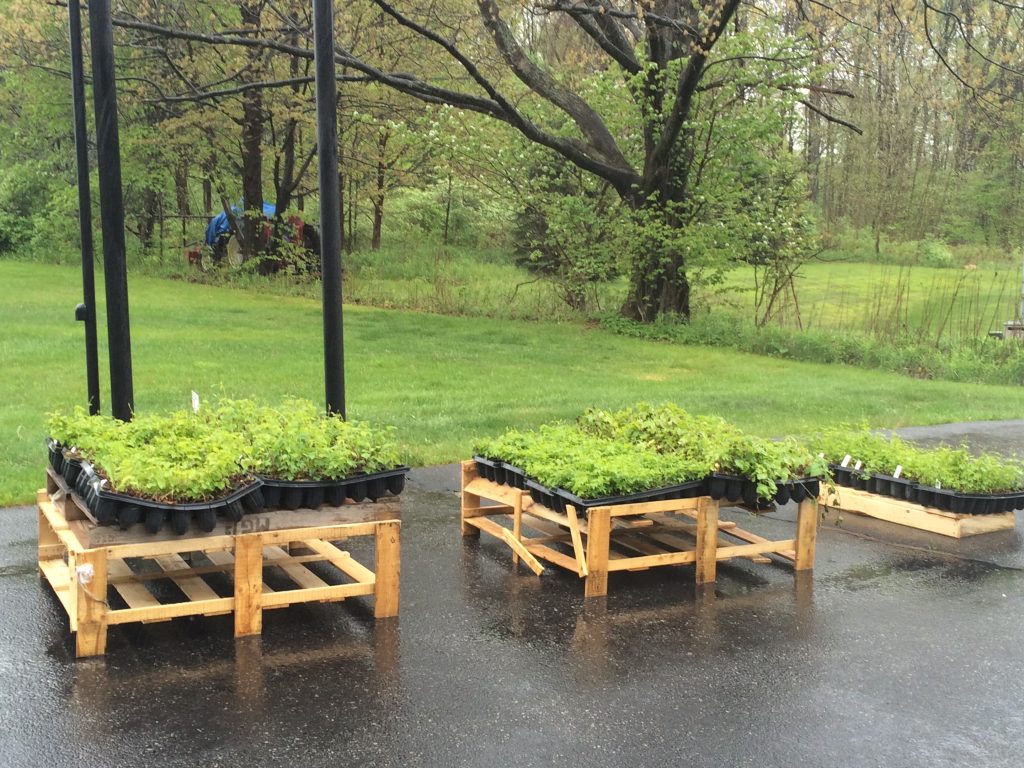
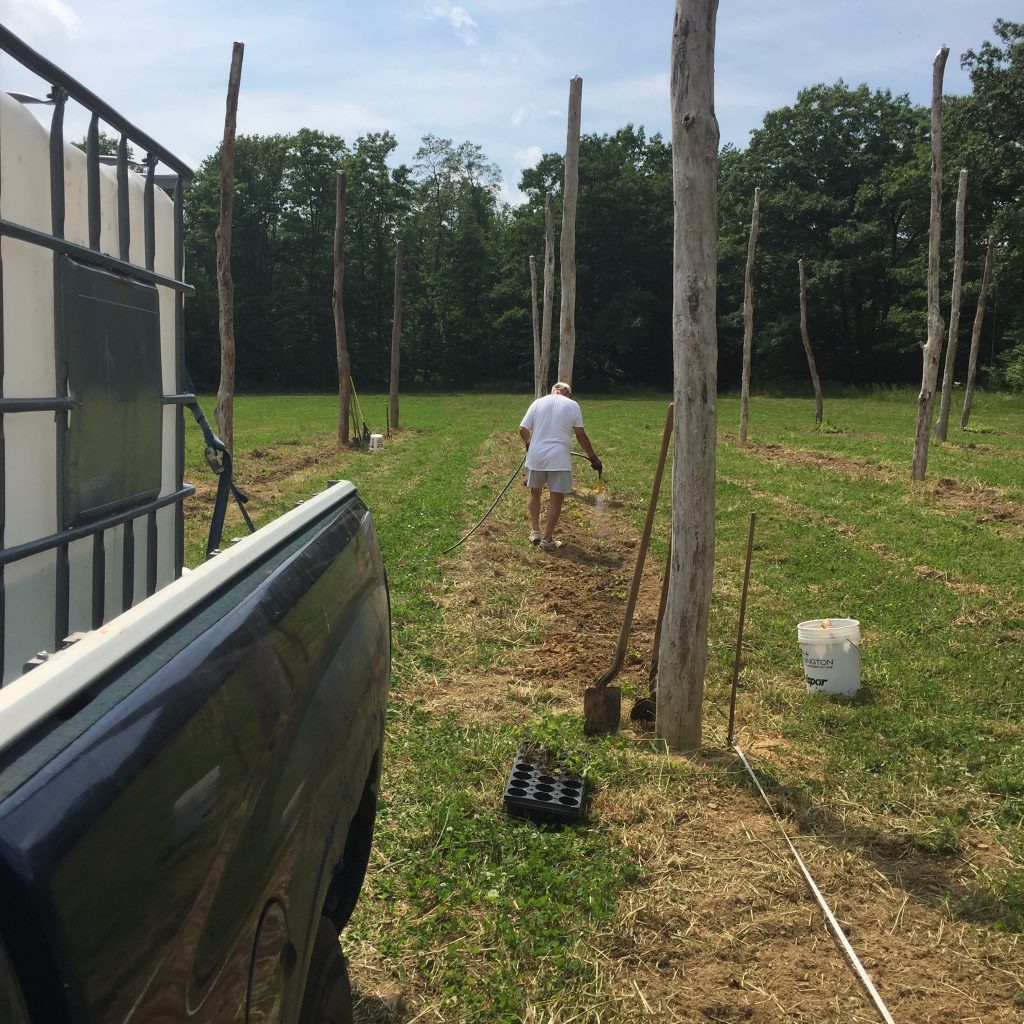
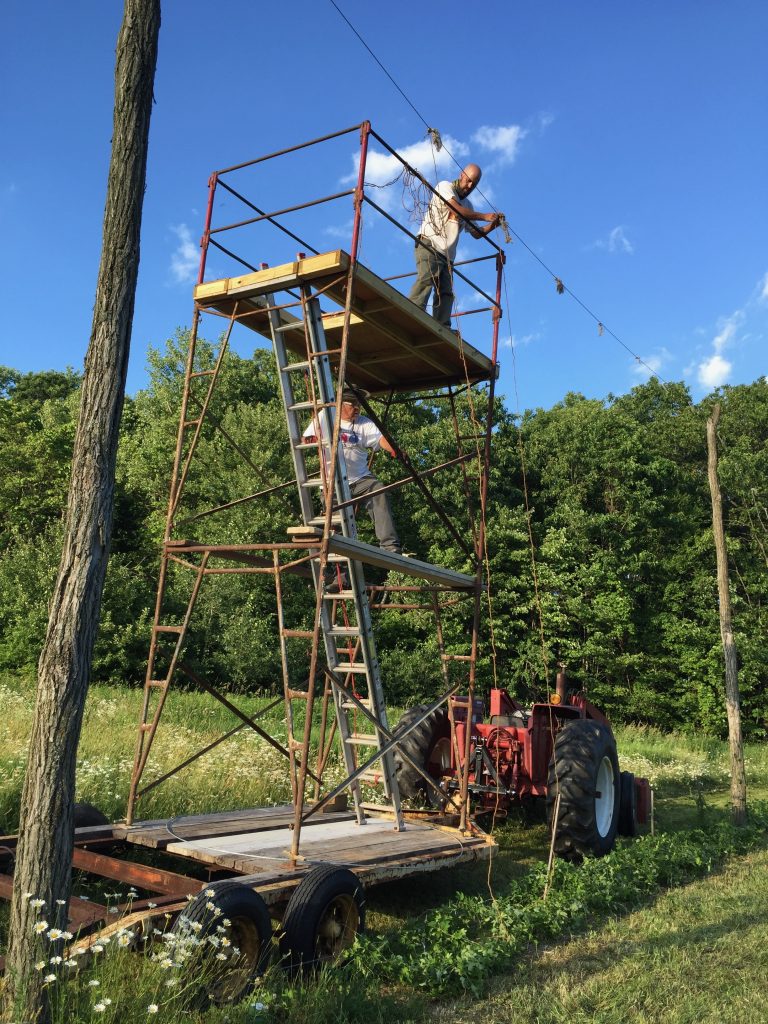
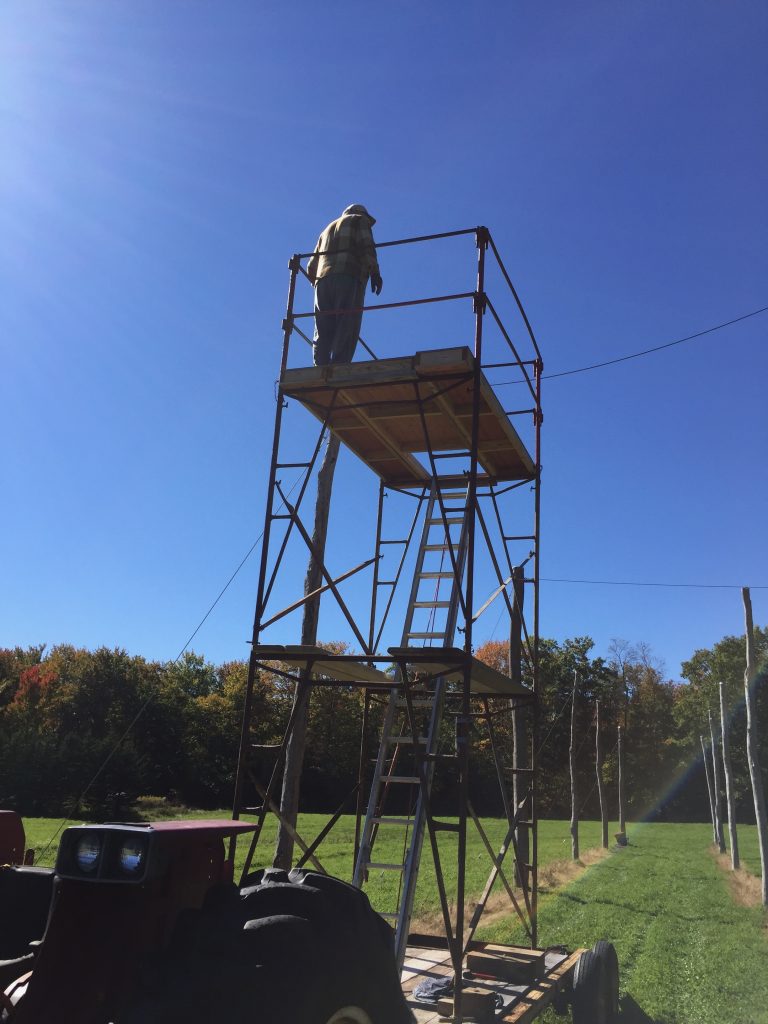
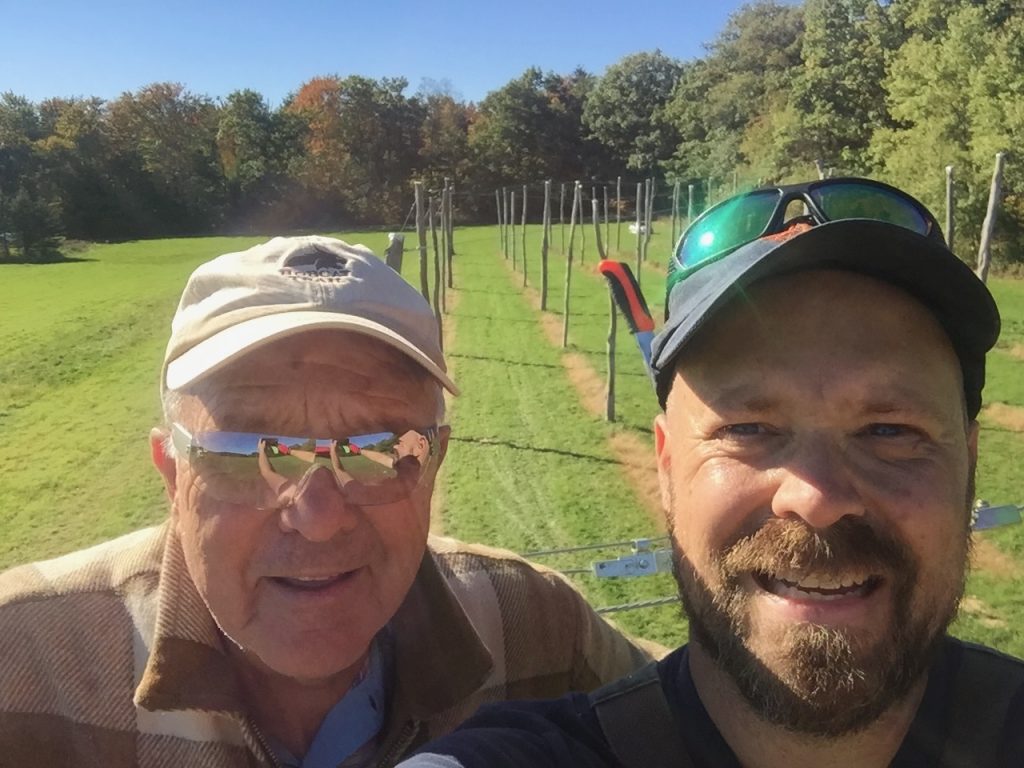

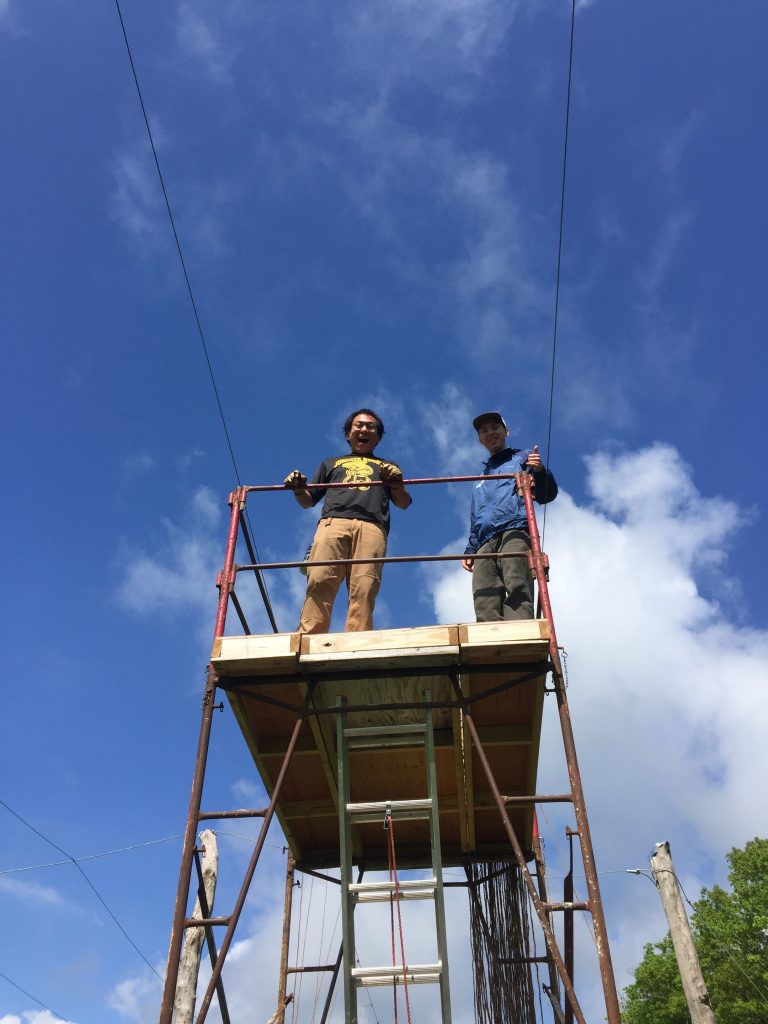
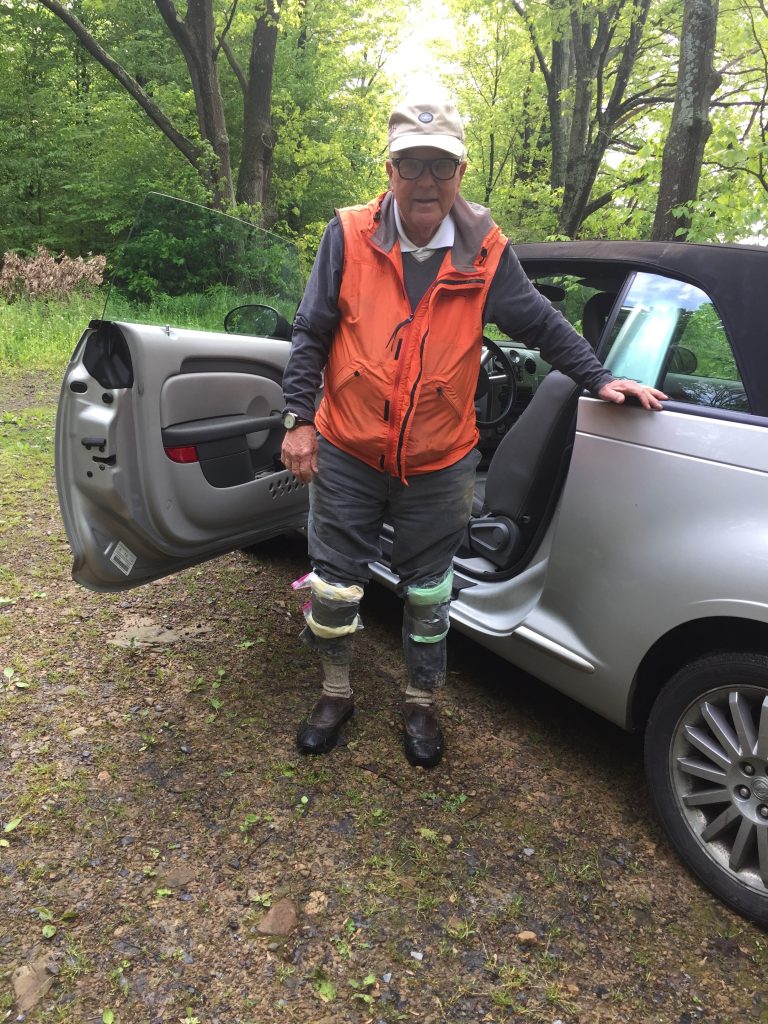
It was akin to just learning how to juggle, and then adding the unicycle, plates, and dancing bear the moment you feel you got the hang of the 3 rubber balls. The new hops arrived early due to a miscommunication with the grower, and the hills weren’t ready yet. So they sat in their flats for 3 weeks with my Dad watering them daily, while we rushed to finish the hills in the new yard and keep the small yard as tidy as we could. That is to say, the new hop hills weren’t properly tilled and prepped, and the small yard didn’t get strung until AFTER the Summer solstice – the point at which they should already be at the top of the wire. It was chaos.
We got the transplants in, again in less-than-ideal soil conditions, got the large yard strung, and away we went. Now we had five varieties planted originally in the large yard; Cascade and Nugget which we also had in the small yard, along with Horizon, Brewer’s Gold, and Vanguard. The three new varieties came at the request of the brewery and it should’ve been on us to check to see if those three varieties showed promise elsewhere in the Mid-Atlantic region where we’re located. Temporarily fast-forwarding to 2019, we determined they were not. We tended to them and encouraged them for the first 2 years, the third year they just kinda hung out in the yard without much care, as we worked to keep the Cascade and Nuggets going. By 2021 we’d decided we just needed to till everything under and start again.
Another Go At the Grant Process – Solar Power and Drip Irrigation

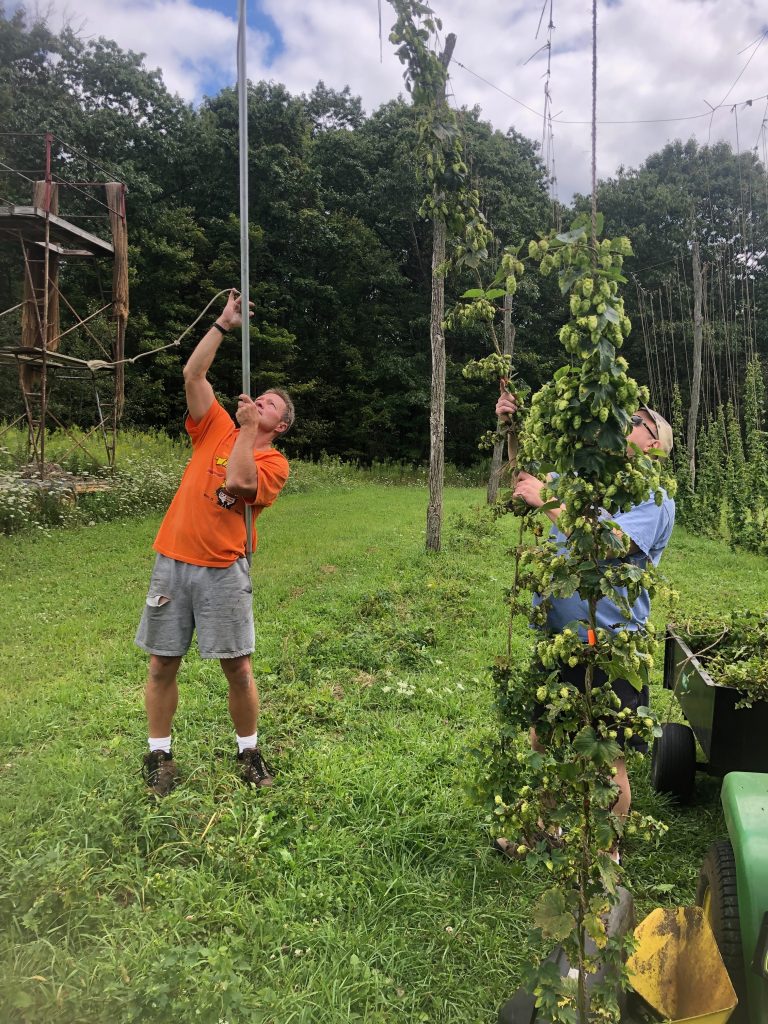
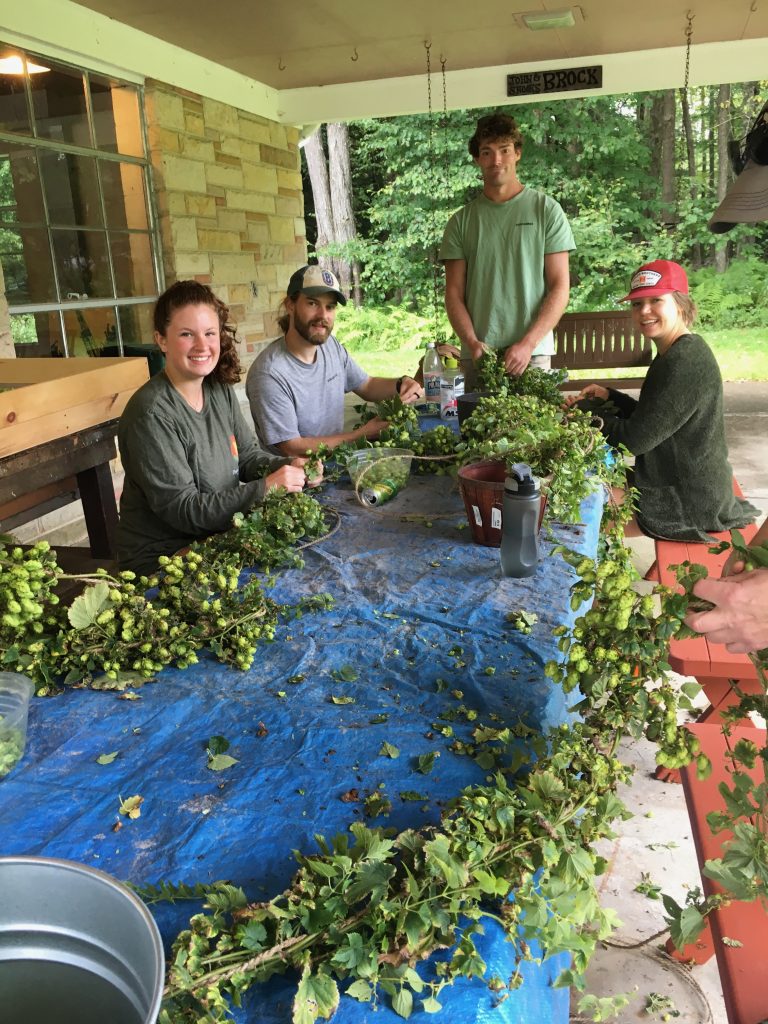

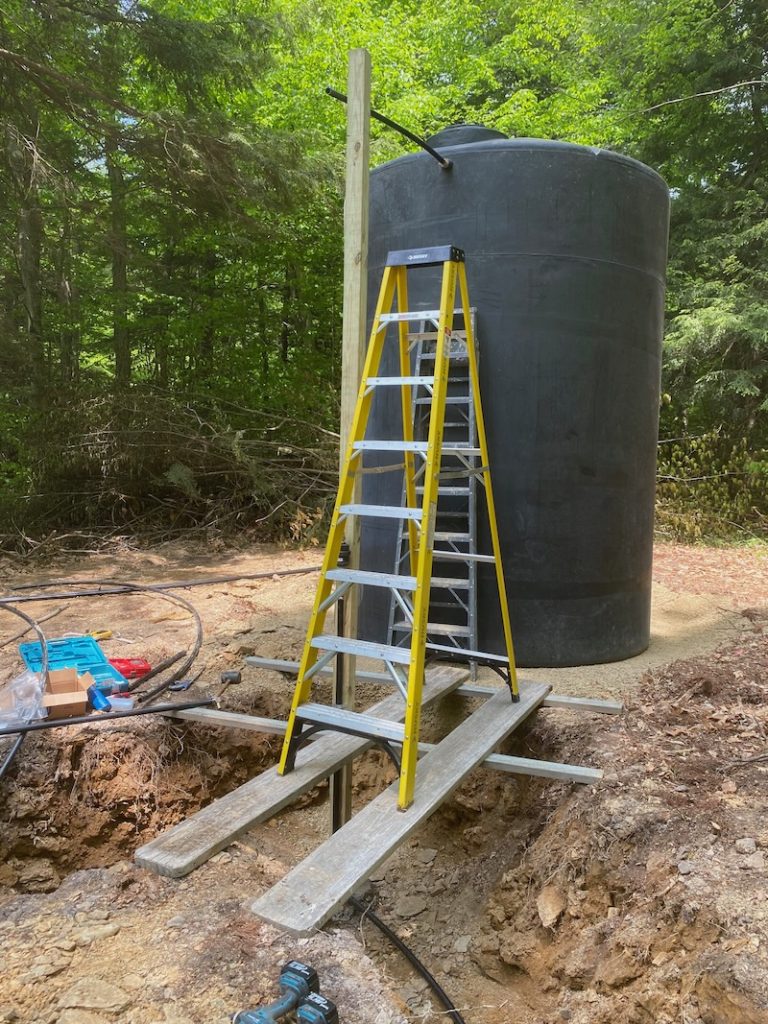
First off, thanks for hanging in there this long! I’ve started and stopped on this article five times at least over a month. My intent was not to create a post this long, but rather a summary of where we started and how we got to present day 2023. But as I got further along, I realized…
Sometimes The Light’s All Shining On Me
“Truckin'”
Other Times I Can Barely See
Lately It Occurs To Me
What A Long Strange Trip It’s Been
The Grateful Dead
Back to the solar pump and drip irrigation grant. When we put in the larger hopyard, we were already quite aware that getting a consistent volume of water and nutrients to the hops was critical. Getting those two critical components to 30 plants was realistic, to 500, not so much. For the small yard, we’d set up the old 250-gallon water tank we’d used years previous for our vegetable endeavor and purchased drip tape, and a basic timer for it. We then ran a series of hoses up alongside the field from the barn to the small hopyard and as needed, refilled the tank. Again, not ideal, but it worked.
Hops require a lot of water. I’ve seen estimates upwards of 16gal/plant/week. With some 530 plants that’s almost 8,500 gallons of water. It does rain a fair amount in our region, but nowhere near that level. Additionally, hops require a fair amount of nitrogen replenishment, particularly as they’re prepping for burr stage. Burrs become the cones. We wanted to be able to fertigate (liquid fertilizer) via our driplines. It was hard enough getting water to the small yard, there was no way we could supplement irrigation in the large yard. Thus we began research grants for irrigation systems.
We found one with NRCS’ Environmental Quality Incentives Program (EQIP) program, their “flagship conservation program that helps farmers, ranchers and forest landowners integrate conservation into working lands.” Working closely with our regional NRCS agents, we built and submitted our application and proposal and it was accepted! Yeah us…now we just actually had to put it in place. With the funds we have available, we knew the vast majority of the work would need to be completed on our own. The solar array, pump, pipes, hydrants, etc. would be expensive enough – we couldn’t afford to have a contractor do all the work for us – nor did we want that.
A wrinkle developed when we realized the original proposal from NRCS had us running power up from the barn to the pump. That was a two-fold issue. First, digging an electrical line from the barn to the pump was almost 1,000′. That would’ve eaten up a ton of the budget there. Second and more importantly, the barn was built in the early 1960s and we sometimes can’t run two large pieces of equipment at once as the breakers would constantly pop and need to be reset. It wasn’t wired for something like this. So we proposed adding solar to the system. This was something NRCS was very excited about as it fit directly into their mission.
The next hiccup however related to that was a solar pump really wasn’t meant to be pumping within an irrigation system this large and geographically spread out. As we’d be watering most likely twice a day at least, the pump would be working overtime and wouldn’t be able to push the pressure levels needed. We needed a way to store the water and transport it. Thus, the idea of an above-ground water tank using gravity to feed the system with enough pressure. Great – except the budget didn’t include that. So that part came out of our pockets.



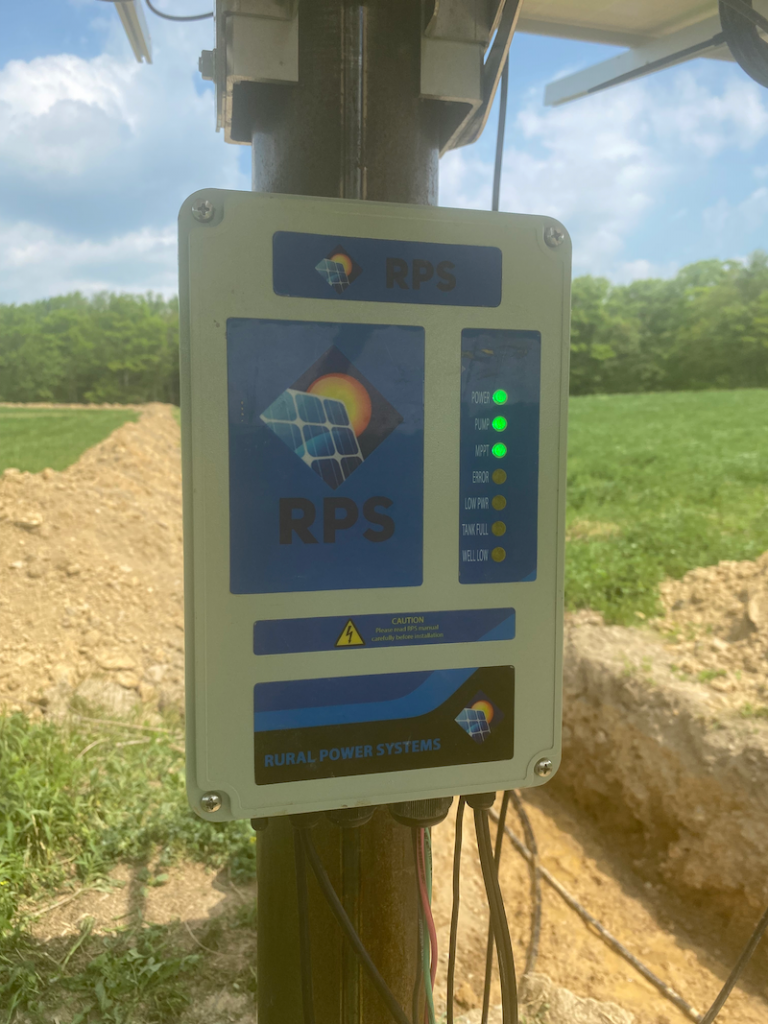

You can read the entire story here, but not to rehash it here…it was a tough project, we were under a deadline we were certain we couldn’t meet, but somehow we did. And it’s been a God-send since day 1 of operation and every day since!
Fast Forward to the End of Season 2023
Coming back full circle here, I think, to where I started with this article 😉 this year’s crop was the first to finally make it into a production brew! We’re still on a high from it and I hope we never forget the feeling. However, there is the large hopyard that has to be replanted back to its original 500+ plant capacity, there are improvements in the harvester that the student cohort from PSU is working on for completion in 2024 (more to come on that), expanded drying capacity, pelletization and packaging…the to-do list is fairly large and aggressive.
We say farewell to 2023 feeling good about what’s been accomplished but looking forward to the possibilities in the years ahead. And so with that, we close this entry just as we’d opened…
“Forward, always forward, everywhere forward“
Boniface Wimmer, O.S.B.
Founder & Archabbot, Saint Vincent Archabbey | Latrobe, Pennsylvania
1809 – 1887
Category: Blog, Hops, Hopyard, Marketing & Social Media, Posts with image Tags: Family Farm, Hop Farm, Hop Farming, Hops, Small Family Farm

